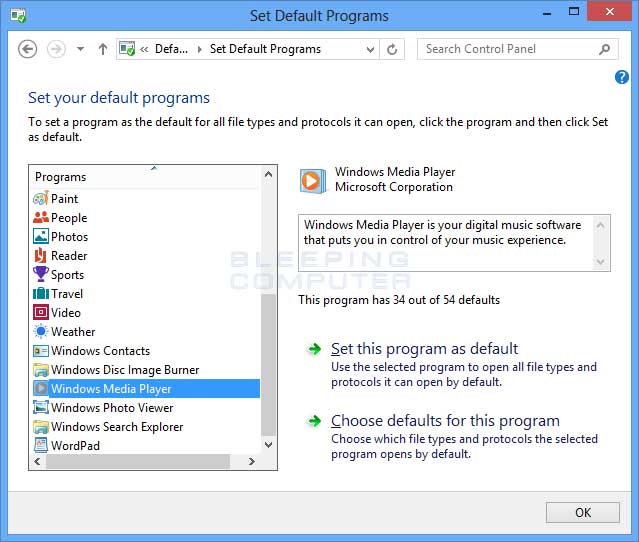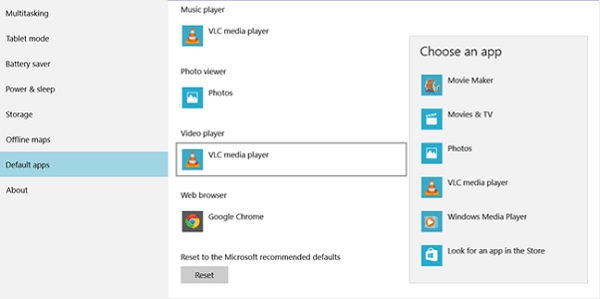
- SET DEFAULT MEDIA PLAYER WINDOWS 7 HOW TO
- SET DEFAULT MEDIA PLAYER WINDOWS 7 INSTALL
- SET DEFAULT MEDIA PLAYER WINDOWS 7 WINDOWS 10
- SET DEFAULT MEDIA PLAYER WINDOWS 7 FREE
- SET DEFAULT MEDIA PLAYER WINDOWS 7 WINDOWS
In other words, if you want to play a file in a special format with another player, you can do that as well.
SET DEFAULT MEDIA PLAYER WINDOWS 7 WINDOWS
Change Windows Media Player for Certain Formatsįortunately, the Windows operating system has many customization options, so you can have multiple players for different tasks. Pick the one you like the most and set it as default, with almost total security these drives are more efficient than the one that comes by default in Windows. If you have trouble choosing the drive, VLC is a great option, but you can still consider some of the best VLC media player alternatives. After these steps, the system default video player app will be properly configured. Īgain, find the "Default apps" section, at this point look for the option « Reader video" and this is where you need to select the video player you want. Once there, go to "Applications and features". Just go to the "Settings" section of Windows, which you will find in the Start menu.

The process for the video player is pretty much the same as changing the music player. Change the default video player in Windows All of these options are a great alternative to Windows Media Player for the most demanding people.
SET DEFAULT MEDIA PLAYER WINDOWS 7 FREE
If you don't have a music player program, you may want to consider some of the best free music players for pc. After doing this setup, every music file you open will be played with the selected app. The last step is to select the music player you want by default. The system default basic applications screen is displayed, locate "Music Player".

Īmong the multiple sections you need to locate "Applications and Features", once you are there, go to the "Default Applications" section. To do this, go to Windows startup and search for the "Settings" application or "Settings on your PC". All we have to do is change a few settings in the "Settings" section of Windows. The procedure for changing the default music playing program is very simple. Change the default music player in Windows Carefully read the following guide with which you will learn how change media player for video and music. If you don't like the default Windows Media Player music and video player app, you can change it very easily.
SET DEFAULT MEDIA PLAYER WINDOWS 7 HOW TO
How to change the default Windows Media Player in Windows Before you begin, you may want to consider some of the best high quality 4k video players, which could be a good option to replace Windows Media Player.

Open Settings, go to Apps > Apps & Features, and click on Manage optional features.With this guide, you will learn change the default Windows Media Player in Windows, by customizing Windows for each type of file you want to play.
SET DEFAULT MEDIA PLAYER WINDOWS 7 INSTALL
If you want the media player back you can install it via the Add a Feature setting. This update, referred to as FeatureOnDemandMediaPlayer, removes Windows Media Player from the OS, although it doesn’t kill access to it entirely. To do this: Select the Start button, and then type system restore. If Windows Media Player stopped working correctly after the latest updates from Windows Update, you can verify that the updates are the problem by using System Restore. Click View all, and then click Windows Media Player Settings. In the search box, type troubleshooter, and then click Troubleshooting. To do so, please follow the steps below: Open the Windows Media Player Settings troubleshooter by clicking the Start button, and then clicking Control Panel.
SET DEFAULT MEDIA PLAYER WINDOWS 7 WINDOWS 10
… Windows 10 instead uses Groove Music (for audio) and Microsoft Movies & TV (for video) as the default playback applications for most media As of May 2020, Windows Media Player is still included as a Windows component. Windows Media Player 12 is the most recent version of Windows Media Player. To do that, select the Start button, then select Settings > Apps > Apps & features > Manage optional features > Add a feature > Windows Media Player, and select Install. … In some editions of Windows 10, it’s included as an optional feature that you can enable. Windows Media Player is available for Windows-based devices.



 0 kommentar(er)
0 kommentar(er)
